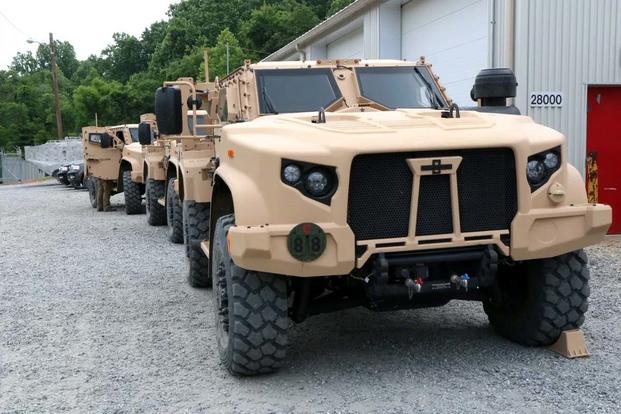The under secretary of the Army said Wednesday that the service plans to buy fewer of the brand-new Joint Light Tactical Vehicles in fiscal 2020 to free up money for future modernization, and is considering reducing its overall requirement for the high-performance combat vehicle.
The service just began fielding its new vehicle in January, but it plans to buy only 2,530 JLTVs in the fiscal 2020 budget request, a significant reduction from last year's purchase of 3,393.
Under Secretary Ryan McCarthy confirmed Wednesday that the JLTV is one of the 93 programs selected to have its funding cut over the next five years to find more than $30 billion for the service's ambitious modernization strategy. Army leaders also terminated another 93 programs across the service's investment portfolio in the name of modernization.
The JLTV became a modernization priority for the Army and Marine Corps after the Humvee proved unable to protect troops from deadly improvised explosive devices, mainly during Operation Iraqi Freedom.
It took almost a decade to develop but, in August 2015, Oshkosh Corp. was selected over Lockheed Martin Corp. and AM General LLC to build the JLTV for the services.
"We had to be ruthless in the prioritization," McCarthy said, said speaking at the 10th Annual Defense Programs conference hosted by McAleese and Associates. "We had to look at how could you finance this ambition in a flat or declining fiscal environment."
Army officials have said it will take the service until the mid-2030s to complete JLTV fielding, which means that most soldiers will go into combat in Humvees if war breaks out in the near term.
McCarthy said the service is considering lowering its requirement for 49,000 JLTVs since it already has 55,000 Humvees and 800 infantry squad vehicles.
"We clearly have more capability than we need," he said. "We are locking in on that number and will publish it soon."
McCarthy would not go into details about the 93 programs the Army terminated but said that the Bradley fighting vehicle and the CH-47 Chinook are among the 93 programs to have funding cut over the next five years to finance modernization programs such as the next-generation combat vehicle and future vertical lift.
The Army plans to equip only five brigade combat teams with the modernized Bradley A4 and move the rest of the program's funding to the next-generation combat vehicle program in 2023, he said.
The service also plans to stop buying Chinooks for the conventional force after fiscal 2020 to fund efforts for a next-generation helicopter as part of the future vertical lift program, McCarthy said.
"We went through and did a full, thorough exercise on the aviation portfolio, and we have 10 percent more Chinooks on today than we need," he said. "So we continue through the buy [in fiscal 2020] for the conventional force, but we will only be buying [Special Operations Command] Chinooks in the outyears."
The Army began laying the groundwork for modernization in its fiscal 2018 and 2019 budgets, realigning about 80 percent of science and technology funding toward its six modernization priorities, which include long-range precision fires, the next-generation combat vehicle, future vertical lift, a mobile network, air and missile defense, and soldier lethality.
In the end, the Army hopes to field a new fleet of combat systems by 2028, replacing the Big 5 -- the M1 tank, Bradley Fighting Vehicle, UH-60 Black Hawk, AH-64 Apache and the Patriot air defense system.
"From a modernization standpoint, our systems -- the Big 5 weapons systems -- are old, in most cases over 40 years old," McCarthy said. "There is only so much more you can engineer out of these systems and still be able to maintain that technological overmatch in the years to come."
-- Matthew Cox can be reached at matthew.cox@military.com.












